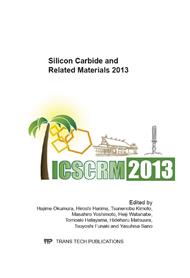[1]
H. Matsuura, Determination Methods of Densities and Energy Levels of Impurities and Defects Affecting Majority-Carrier Concentration in Next-Generation Semiconductors, in: H. Geelvink and S. Reynst (Eds. ), Advances in Condensed Matter and Materials Research Vol. 10, Nova Science, New York, 2011, pp.301-355.
Google Scholar
[2]
H. Matsuura, The Influence of excited states of deep dopants on majority-carrier concentration in a wide-bandgap semiconductor, New J. Phys. 4 (2002) 12 1-15.
DOI: 10.1088/1367-2630/4/1/312
Google Scholar
[3]
H. Matsuura, K. Sugiyama, K. Nishikawa, T. Nagata, and N. Fukunaga, Occupation probability for acceptor in Al-implanted p-type 4H-SiC, J. Appl. Phys. 94 (2003) 2234-2241.
DOI: 10.1063/1.1589176
Google Scholar
[4]
H. Matsuura, Investigation of a distribution function suitable for acceptors in SiC, J. Appl. Phys. 95 (2004) 4213-4218.
DOI: 10.1063/1.1655683
Google Scholar
[5]
H. Matsuura, Influence of excited states of a deep substitutional dopant on majority-carrier concentration in semiconductors, Phys. Rev. B 74 (2006) 245216 1-8.
DOI: 10.1103/physrevb.74.245216
Google Scholar
[6]
H. Matsuura, M. Komeda, S. Kagamihara, H. Iwata, R. Ishihara, T. Hatakeyama, T. Watanabe, K. Kojima, T. Shinohe, and K. Arai, Dependence of acceptor levels and hole mobility on acceptor density and temperature in Al-doped p-type 4H-SiC epilayers, J. Appl. Phys. 96 (2004).
DOI: 10.1063/1.1775298
Google Scholar
[7]
O. Madelung, Semiconductors: Data handbook, 3rd ed., Springer, Berlin, (2004).
Google Scholar
[8]
M. Ikeda, H. Matsunami, and T. Tanaka, Site effect on the impurity levels in 4H, 6H, and 15R SiC, Phys. Rev. B 22 (1980) 2842-2854.
Google Scholar
[9]
I. Nashiyama, Energy levels of impurities in SiC, in: G. L. Harris (Ed. ), Properties of Silicon Carbide, INSPEC, London, 1995, p.87.
Google Scholar
[10]
S. M. Sze and K. K. Ng, Physics of Semiconductor Devices, 3rd ed., Wiley, New York, (2007).
Google Scholar
[11]
Y. P. Maslakovets, E. N. Mokhov, Y. A. Vodakov, and G. A. Lomakina, Diffusion of Beryllium in Silicon Carbide, Sov. Phys. Solid State 10 (1968) 634-638.
Google Scholar
[12]
J. P. Biersack and L. Haggmark, A Monte Carlo computer program for the transport of energetic ions in amorphous tergaets, Nucl. Instr. and Meth. 174 (1980) 257-269.
DOI: 10.1016/0029-554x(80)90440-1
Google Scholar


